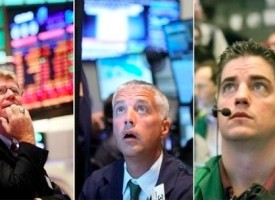Getting hungry? More waves of inflation are on the way and food costs keep climbing.
GETTING HUNGRY: FOOD COSTS KEEP CLIMBING
February 28 (King World News) – Gerald Celente: In January, the cost of groceries in the U.S. was 1.2 percent higher than a year earlier and menu prices at restaurants jumped 1.2 percent, according to data from the U.S. Labor Department.
“Historically, after periods of inflation, there’s no period you could point to where food prices go back down,” Steve Cahillane, CEO of snack maker Kellanova, told The Wall Street Journal.
In 1991, U.S. households spent 11.4 percent of the disposable income on food, U.S. Agriculture Department data shows. In 2022, the proportion was 11.3 percent, indicating that food prices have grown apace with incomes.
While commodity prices have risen, companies have also indulged in “greedflation.” In 2022 and 2023, several companies were found to have jacked their prices beyond their rise in costs to protect their profits at the literal expense of consumers.
We reported this pattern of behavior…
Listen to the greatest Egon von Greyerz audio interview ever
by CLICKING HERE OR ON THE IMAGE BELOW.
Denny’s and Wendy’s are among the restaurant chains reporting fewer guests in 2023 than in 2022 as more and more consumers are pinching pennies. Heinz and Hershey have said their sales volumes declined as their prices rose with inflation.
More is to come: Mondelez, which makes Oreo cookies and other snacks, has warned it will continue to raise prices; the cost of cocoa has broken a 46-year price record.
Also, last month 22 states hiked their minimum wage. California’s is set to jump 25 percent starting in April.
“It’s a really fast move and a high percentage increase,” Brian Niccol, CEO of Chipotle Mexican Grill, said to the WSJ. “Pricing [the increase into menus] is going to be part of the puzzle.”
As a result of slipping sales, investors seem to have soured on food company stocks. The Standard & Poor’s restaurant subindex has risen about 10 percent during the 12 months ending 21 February, while the S&P as a whole has grown by about 25 percent.
Another S&P subindex monitoring packaged foods and meat share prices has sunk about 8 percent over the same period…
This silver explorer recently did a huge transaction with a $4.5 billion market cap producer CLICK HERE OR ON THE IMAGE BELOW TO LEARN MORE.
TREND FORECAST:
The cost of individual food items such as bread or eggs will continue to tick up and down, but grocery prices overall will remain high.
Increasingly frequent weather extremes will threaten harvests. Businesses will need to pay workers a living wage. Just as important, food manufacturers and grocery chains feel more beholden to shareholders and Wall Street analysts than to the public, ensuring that “greedflation” to protect profit margins and stock dividends will remain part of our grocery bill.
TRENDPOST:
With The Wall Street Journal reporting that Americans are spending more than 10 percent of their earnings on food—the most they have in 30 years and USA TODAY noting that the average family is spending more than $1,000 on groceries each month… market shills are selling “not to worry” alternatives.
Plantation workers of Slavelandia can’t afford to eat well, don’t worry about it… swallow Kellogg’s crap and buy into its advertising campaign to eat “cereal for dinner.”
Bragging about the success of the advertising campaign in an interview with CNBC, Kellogg’s CEO, Gary Pilnick said it is “landing really well” with American consumers and that “If you think about the cost of cereal for a family versus what they’d otherwise do, that’s going to be much more affordable.”
To listen to Alasdair Macleod discuss what is happening behind the scenes in the gold and silver markets CLICK HERE OR ON THE IMAGE BELOW.
© 2024 by King World News®. All Rights Reserved. This material may not be published, broadcast, rewritten, or redistributed. However, linking directly to the articles is permitted and encouraged.










